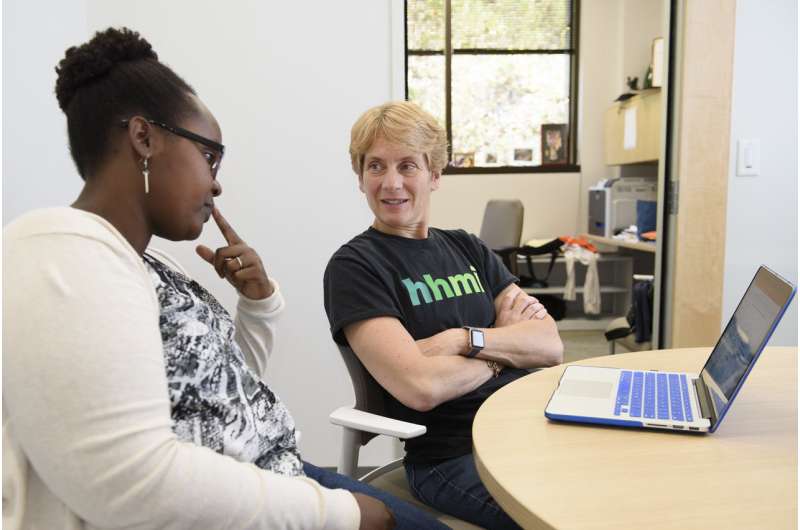New test brings reliable tuberculosis diagnosis to rural Africa

Tuberculosis, a distant memory to most Americans, remains a serious public-health threat in developing countries, in part because the most common test for the disease was developed a century ago and is not the most reliable. Now, a team of basic chemists working in collaboration with doctors and public health researchers in South Africa has developed a new test that makes it easier to diagnose and therefore treat the disease.
The new test, which the researchers describe Feb. 28 in the journal Science Translational Medicine, is designed to work quickly and in places with few of the amenities – even seemingly basic ones like refrigeration – that many of us take for granted, said Carolyn Bertozzi, a professor of chemistry and senior author on the study.
Addressing that challenge took some luck, tuberculosis acumen and passion. "I'm from Burundi – I grew up around infectious disease," said Mireille Kamariza, a graduate student in Bertozzi's lab, who with former Bertozzi graduate student Peyton Shieh is the paper's co-first author. "I am passionate about contributing to that in one way or another."
Four walls, a roof and a door
For those used to modern, high-tech medical care, it can be hard to grasp just what kind of challenge tuberculosis is in places like rural South Africa. Here in the U.S., sophisticated tests yield detailed information, down to the particular strain a patient has. But to work, those tests require conveniences that most Americans take for granted – electricity to run even the most basic equipment, refrigeration to keep test chemicals stable and, perhaps most important, time.
Rural clinics in developing countries – and some urban clinics as well – may not have such luxuries. Some of those clinics are little more than sheds to provide shade and privacy, and they often lack electricity, running water or money to run complicated tests. Patients, meanwhile, often travel long distances to get to a clinic and may or may not return for test results and treatment.
"You're talking about places where complicated technologies that we develop here just don't translate," said Bertozzi, who is also a faculty fellow of Stanford ChEM-H. The best current option, she said, and by far the most common TB diagnostic worldwide, is the Ziehl-Neelsen stain, a test developed in the late 19th century. But while it is inexpensive, it is neither simple nor especially fast or reliable – in fact, the Ziehl-Neelsen test cannot even differentiate between living and dead tuberculosis bacteria.
Fast, cheap and good
Bertozzi and her lab have been studying tuberculosis for 20 years. Among their most important discoveries was that of a special sugar molecule, called trehalose, that only living tuberculosis bacteria consume and that other bacteria eschew. Bertozzi's goal back then was mainly to understand how tuberculosis worked, but over time she realized her results might have clinical significance as well.
"More and more I would hear talks from people who were in the field trying to deploy new drug ideas or new diagnostics, and it's been difficult because the environments in which you need to be able to get an accurate diagnosis and then manage the treatment of people with TB are so underresourced," Bertozzi said.
What those people needed, in other words, was a test that was fast, cheap and good. Usually, engineers will tell you, you get to choose just two, but Bertozzi, Kamariza and their colleagues accomplished all three with a solution based on what they'd learned previously about the tuberculosis bacteria's penchant for trehalose. They attached the sugar to a fluorescent dye that, once ingested, glows about 700 times brighter than before: Spot a very bright cell, and live tuberculosis must be present.
The test, called DMN-Tre, takes just a few steps and produces results in under an hour. Because of the test's speed, doctors may be able to test antibiotics against sputum samples to quickly find the right antibiotics for the particular strain a patient carries.
From Stanford to Johannesburg
Still, the real test comes not in the lab but out in the real world with real patients. For that the researchers turned to collaborator Bavesh Kana and his team at the University of Witwatersrand in Johannesburg, South Africa. They conducted tests on 40 tuberculosis patients who had not yet been treated for the disease. DMN-Tre, the researchers found, performed as well as existing tests that took more steps to complete.
Another important test will be seeing whether they can accurately track the decline of tuberculosis bacteria in drug-treated patients, which will take much longer, Kamariza said. Those bacteria, she said, can take three months or more to clear out of a patient's system, so it will be important to assess whether DMN-Tre can help quickly determine drug efficacy during patient treatment in rural areas.
The work so far has already opened up a number of new possibilities, Bertozzi said. Other researchers in South Africa are looking at whether it could help diagnose TB in patients with HIV, for whom standard sputum tests often do not work. DMN-Tre could also help researchers trying to understand how tuberculosis circulates in rooms and buildings. "There is a lot about the life cycle of tuberculosis that people don't understand, and it's hard to study," Bertozzi said. "This tool could be an enabling reagent for a variety of tuberculosis-related research projects."



















